
































October 2024 • Volume 13, No. 12
CEO Michael Shepard
VICE PRESIDENT OF CONTENT Leon Espinoza
EDITORIAL DIRECTOR Mike Teegarden, CCC
DEPUTY EDITORIAL DIRECTOR
Noble Sprayberry
SENIOR EDITOR Jennifer Paton, CCC
FLORIDA CURRENTS EDITORS
Chasity Anderson, CCC; Valeri Pearon
ASSISTANT EDITORS Victoria Hampton, CCC;
David Herder, CCC
ASSOCIATE EDITOR
Nina Todea
PUBLICATIONS PRODUCTION
SENIOR MANAGER
Elizabeth Beatty
SENIOR PUBLICATIONS COORDINATOR
Alyssa McDougle
Members acknowledge that $4.49 a year, plus postage, is the cost to publish 12 issues a year of FLORIDA CURRENTS ISSN 23276304 (USPS 8300). Published by Pioneer Utility Resources Inc., 5625 NE Elam Young Pkwy. Ste. 100, Hillsboro, OR 97124—a not-for-profit Oregon cooperative corporation—the magazine serves the communication needs of consumerowned electric utilities in Florida. Preferred Periodicals postage paid at Hillsboro, OR 97123 and at additional mailing offices.
Postmaster: Send address changes to 5625 NE Elam Young Pkwy., Ste. 100, Hillsboro, OR 97124-6422.
HOW TO CONTACT FLORIDA CURRENTS
Subscription services:
Nonmember subscriptions $15 U.S. a year; $25 foreign a year. Prepayment required. Allow 4-8 weeks for first issue. Identify local edition desired. Have a problem receiving your magazine? Utility members should contact their utility office. Nonmembers call 503-357-2105 or email mailingdept@pioneer.coop.
Back issues:
Back issues and extra copies are $3 each, prepayment required. Supply is limited. Identify edition, month and year. Call first to check availability. Contact Pioneer Utility Resources: P.O. Box 1306, North Plains, OR 97133-1306; 503-357-2105; email: mailingdept@pioneer.coop.
DISPLAY ADVERTISING INQUIRIES
American MainStreet Publications 611 S. Congress Ave. Ste. 504 Austin, TX 78704-1714; 800-626-1181 or 512-441-5200; amp.coop.
© 2024 Pioneer Utility Resources. All rights reserved. Reproduction in whole or in part without written permission is prohibited. Direct reprint requests to editor@floridacurrents.com or for more information, visit www.pioneer.coop.
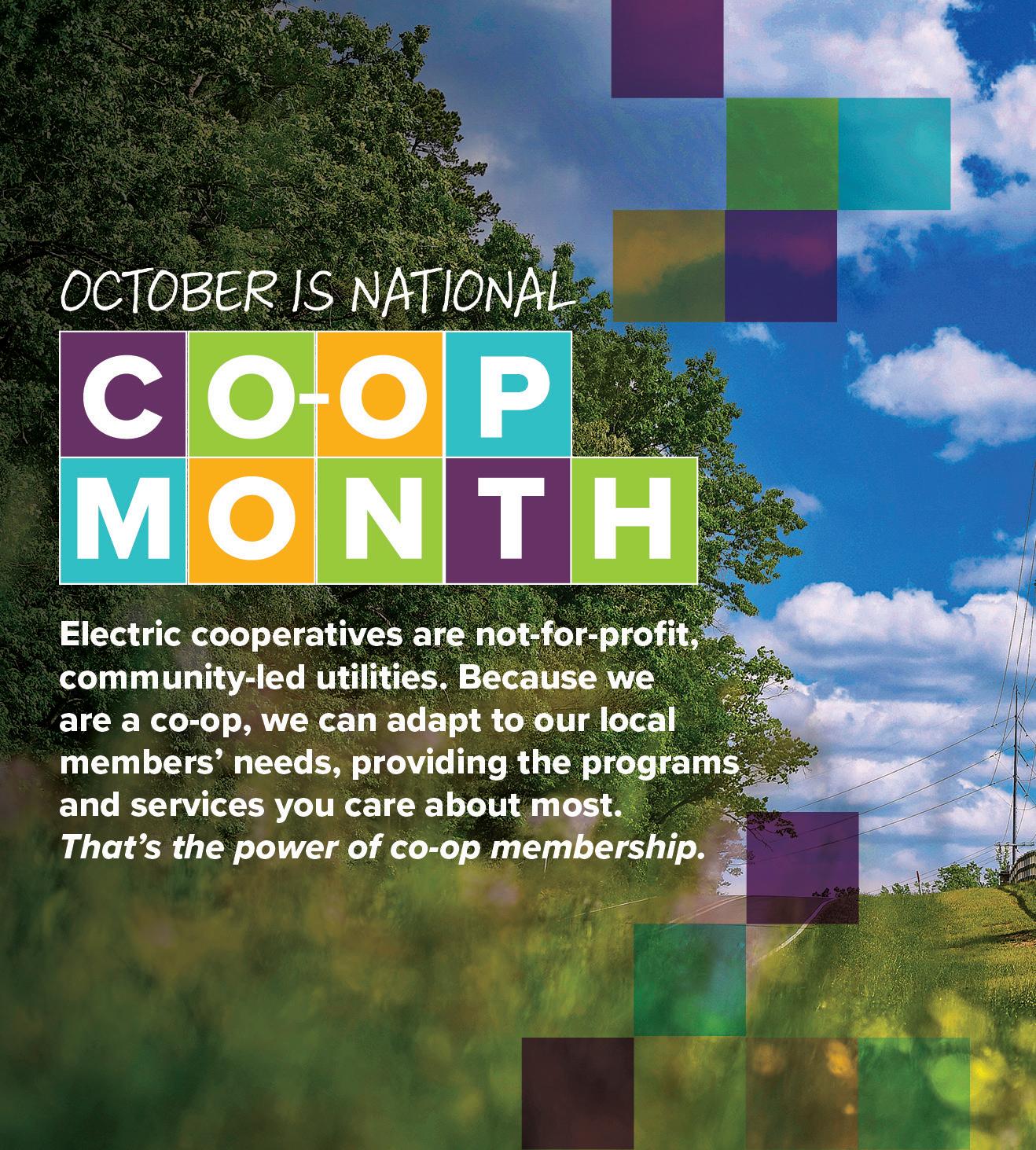
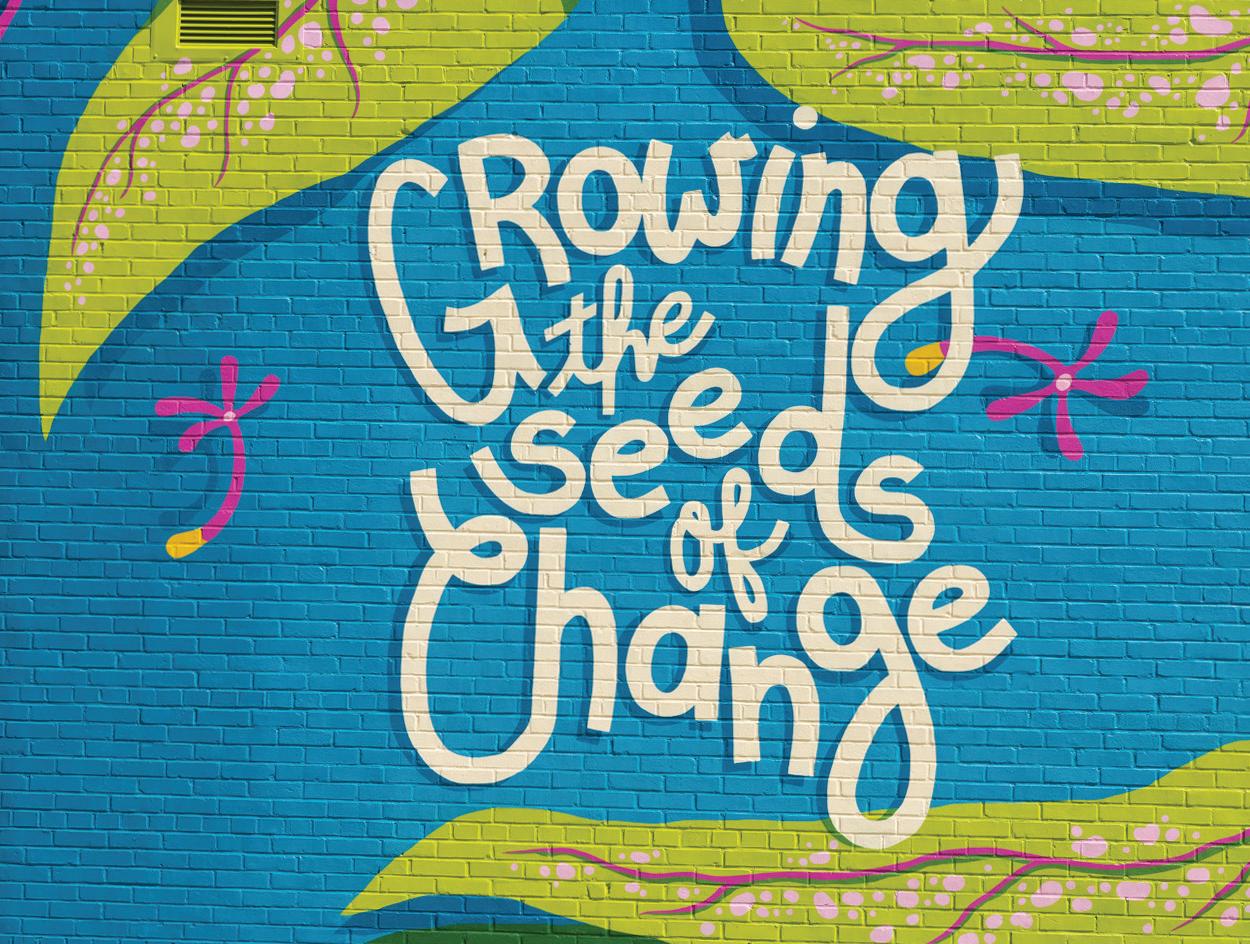







Beloved Gulf Coast Electric Cooperative Trustee Kinneth Daniels passed away Aug. 25, at his home in Kinard. He was 89.
Mr. Daniels was born in Kinard on May 13, 1935, to the late Lillie and Joseph Daniels. He was a lifelong resident of Kinard, where he graduated high school in 1953. He started driving a bus for Calhoun County students to take classes at Chipola College in Marianna. He began taking classes himself and graduated with an associate’s degree.
He served in the United States Air Force and worked as an electronics technician with the Federal Aviation Administration for 35 years. He was a 58-year member of Cypress Creek Baptist Church, where he served as a deacon and the caretaker of Cypress Creek Cemetery for many years. He also worked as an electrician for the Calhoun County School System.
Mr. Daniels was GCEC’s District I, Group 3 trustee, representing members residing in Calhoun County, west of the Chipola River. During Mr. Daniels’ 29 years on the GCEC Board of Trustees, he held the positions of president, secretary and treasurer. Mr. Daniels also earned the Credentialed Cooperative Director Certification and served on the PowerSouth Energy Cooperative Board of Trustees and the Florida Electric Cooperatives Association Board of Directors.
Survivors include his wife, Marian Daniels; his sons, Kinneth Daniels Jr., Keith Daniels (Connie) and James Daniels (Korrie); his brothers, J.A. Daniels (Alice), Willie Daniels (Wanda), Larry Daniels (Donna), Harold Daniels (Shirley) and Herman Daniels (Marilyn); his grandchildren, Aaron (April), Alanna (Mike), Jared (Katie), Ashley (J. Michael), Tessa and Cade; and his greatgrandchildren, Carter, Beckett and Griffin.
Services to celebrate Mr. Daniels’ life were held Aug. 28 at Adams Funeral Home in Blountstown and Cypress Creek Cemetery in Kinard. We are keeping the Daniels family in our thoughts and prayers as they go through this difficult time. n

Do you hit the snooze button when someone starts talking about kilowatts, electricity use or energy efficiency? It’s true—sometimes, these can be pretty dry topics. What if you could get money back to make your home more energy efficient? And you could continue to keep more cash in your wallet every month because of those efforts?
Here’s the Scoop
Uncle Sam will pay you to make your home more energy efficient. If you’ve upgraded appliances or made home weatherization improvements to your primary residence since 2023, you may be eligible for tax credits or rebates for energyefficient improvements.
Here’s a sampling of what’s covered: upgraded exterior windows and doors, insulation, high-efficiency (Energy Star-rated) heat pumps, water heaters, heating and cooling equipment, appliances, switching to an electric vehicle, and adding a home charger or rooftop solar system.
So, how does it work? Federal tax credits of up to $3,200 per year can be claimed with your federal income taxes for the year when the upgrades are made. Complete IRS Form 5695, follow IRS instructions and include the form when filing your tax return.
You’ll need to know the total cost of the upgrades and include relevant receipts. Given how annual total limits are structured, consider spreading your home energy-efficiency improvements over a few years. Planning your upgrades can help maximize the annual credit amounts you can claim. As with any tax matter, consulting a tax professional is a good idea.
While the Internal Revenue Service manages the federal tax credits, federal energy rebates are handled by the states. Check to see if your energyefficiency improvements qualify for a rebate. Keep in mind, you’ll need similar documentation and the total amount spent on the upgrades.
Your wallet will thank you for the effort required to get the cash back. Bonus! Gulf Coast Electric Cooperative has additional incentives.

Are you leaving money on the table?






























































































































Grab Those Federal Energy-Efficiency Incentives!
If you’ve recently made home weatherization improvements or energy-efficiency upgrades, you may be eligible for a federal tax credit or rebate. Contact us to learn more.
Play it Again
Let’s recap why it (literally) pays to amp up your energy-efficiency efforts. Energy-efficient upgrades typically reduce consumption, lower utility bills over time and lessen the environmental impact.
Not to mention, you can say goodbye to drafts and cold spots with energy-efficient windows and doors and hello to improved indoor air quality with cleaner heating and cooling systems. So, what are you waiting for?
The Bottom Line
GCEC can help decode energy-efficiency incentives and rebates to max out savings and other benefits. After all, we’re all about helping our members save money and energy. Contact us to learn more about how you can take advantage of these federal incentives and other ways to start putting more money back in your wallet. Other great websites to check out are energy.gov and energystar.gov.
Did you know the average household with internet access owns approximately 17 connected devices? That covers a wide range of electronics, including smart phones, computers, streaming devices, smart speakers and home assistants. Given our increasing reliance on internet-connected technologies, the likelihood of new cyber threats is ever-present.
Gulf Coast Electric Cooperative is committed to ensuring our local system is safe and secure. We routinely monitor and manage cyber risks and work together with other co-ops to share advancements in cybersecurity measures that make us stronger.
And you can help, too.
When we all work together to stay safe online, we lower the risk of cyber threats to our systems, online accounts and sensitive data.
October is National Cybersecurity Month, and while good cyber hygiene should be practiced year-round, we’d like to share a few cybersecurity tips to help you bolster your online safety.
• Learn how to spot and report phishing attempts. Phishing occurs when criminals use phony emails, direct messages or other types of digital communications that lure you to click a bad link or download a malicious attachment. If you receive a suspicious email or message that includes urgent language, offers that seem too good to be true, generic greetings, poor grammar or an unusual sender
address, it could be a phishing attempt. If you spot one, report it as soon as possible—and don’t forget to block the sender. If you receive a suspicious work email, report it to the appropriate IT contact. Suspicious messages that are delivered to your personal email or social media accounts can also be reported.
• Create strong, unique passwords. When it comes to passwords, remember length and complexity work in tandem. Strong passwords contain at least 12 characters and include a mix of letters, numbers and symbols. Create unique passwords for each online account you manage and use phrases you can easily remember.
• Enable multifactor authentication when available. Multifactor authentication—also known as 2-factor authentication—adds an extra layer of security to your online accounts. These extra security steps can include facial recognition, fingerprint access, or one-time codes sent to your email or phone.
• Update software regularly. Software and internet-connected devices, including personal computers, smartphones and tablets, should always be current on updates to reduce the risk of infection from ransomware and malware. When possible, configure devices to automatically update or notify you when an update is available.
Let’s all do our part to stay cyber smart and create a safer digital world for all. For more cybersecurity tips, visit staysafeonline.org.

It was a warm summer afternoon and my wife and I were mingling with the best of them. The occasion was a 1920s-themed party, and everyone was dressed to the nines. Parked on the manse’s circular driveway was a beautiful classic convertible. It was here that I got the idea for our new 1920s Retrograde Watch.
Never ones to miss an opportunity, we carefully steadied our glasses of bubbly and climbed into the car’s long front seat. Among the many opulent features on display was a series of dashboard dials that accentuated the car’s lavish aura. One of those dials inspired our 1920s Retrograde Watch, a genuinely unique timepiece that marries timeless style with modern technology. With its remarkable retrograde hour and minute indicators, sunburst guilloche face and precision movement, this design is truly one of a kind. What does retrograde mean? Instead of displaying the hands rotating on an axis like most watches, the hands sweep in a semicircle, then return to their starting point and begin all over again.


Retrograde watches by the big brands can set you back thousands; one recent offering from a big French fashion house is selling for more than $150,000! But because we’ve designed the 1920s Retrograde Watch in-house, we can offer it to you for just $99!
This watch is so wildly popular with our customers that we’re actually concerned about running out; we only have 937 729 left for this ad!


Join more than 1 smart people who love stauer watches

Watch Specifications:
• Precision movement
• Stainless steel case, caseback and crown
• Retrograde hour and minute indicators
• Water-resistant to 5 ATM
• Brown genuine leather band
• Fits wrists up to 8"
1920s Retrograde Watch
$399 $99* + S&P Save $300



*Special price only for customers using the offer code.


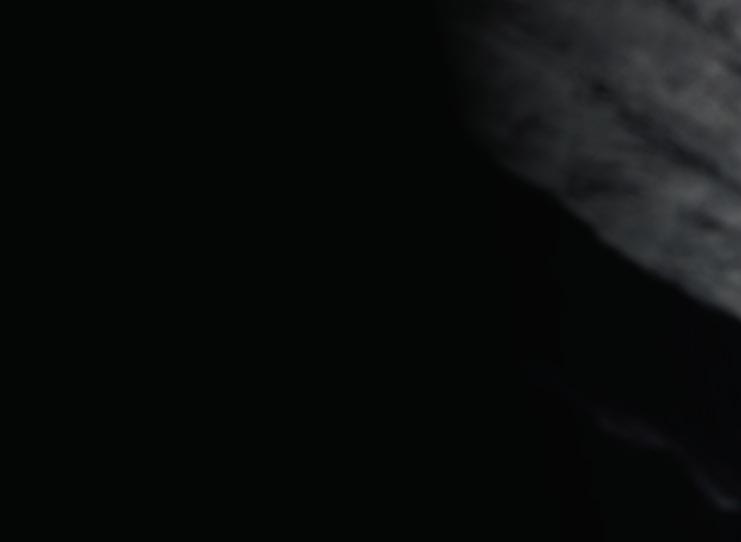




“An elegant and exciting timepiece that every collector will love.”
— George omas, internationally renowned watch expert
“[A] unique and beautiful timepiece.”

— Carlos C., Los Banos, CA




















Kevin Elliot is passionate about creating connections. He makes them through storytelling, creativity and heart. After building businesses that paid the bills and a successful teaching career, he has now found an endeavor that feeds his passion and supports people and causes he believes in.
As co-founder of Wewa Films, Kevin makes his living by shedding light on many of the hometown people and causes he holds dear. When he and his business partner, Courtney Gaskin, started the company, he saw it as a way to explore his love of documentary filmmaking.
What followed has gone far beyond that, allowing Kevin to create opportunities for corporations, destinations and small businesses to tell their own stories and connect to audiences, customers and the community.
“We like to show the people at the heart of the business,” Kevin says. “The basis of any business is a collection of people.”
He believes that how those people connect to what they do and the stories behind why they do it are intriguing.
“That’s what really attracts people to your business,” he says. “When we started, we wanted to do documentaries.
We started putting our own stuff out there, and businesses started calling.”
It began with profiles of local artists and craftspeople. The docuseries called “CRAFT” is posted on the company’s website, where it is described as “our love letter to artists and artisans.”
Since then, they have done the same for destinations, including California’s Central Coast, Gulf County and Panama City, as well as for large corporations like McDonald’s and Toyota, showing a side of the client that touches audiences in unexpected ways. Humanizing the brand is the goal, Kevin says.







TheDowntownBoxingClubwasoneofthe localvenuesshowingdocumentaries duringtheRedfishFilmFestinApril.


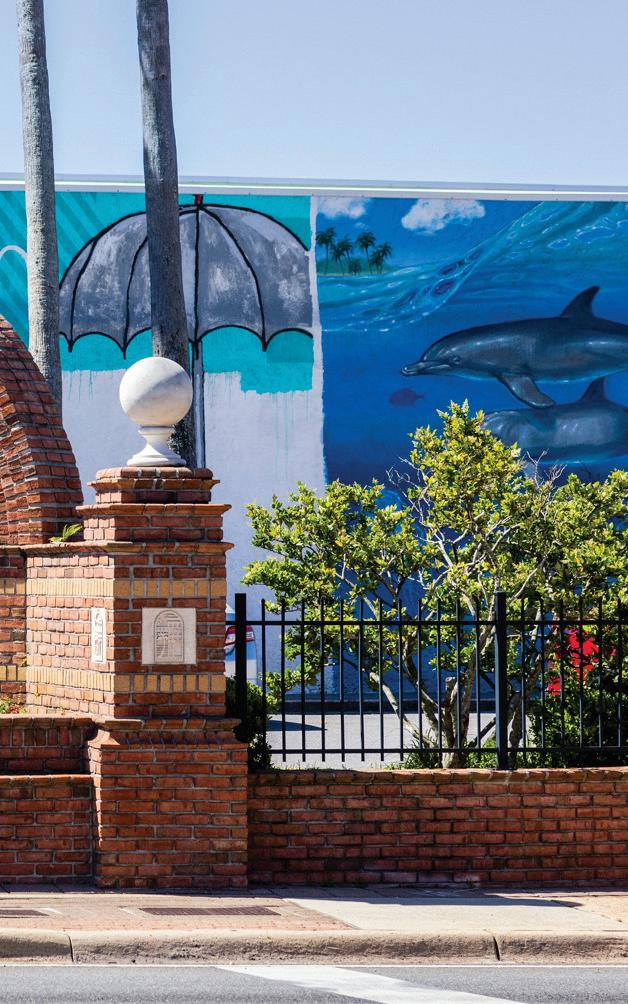


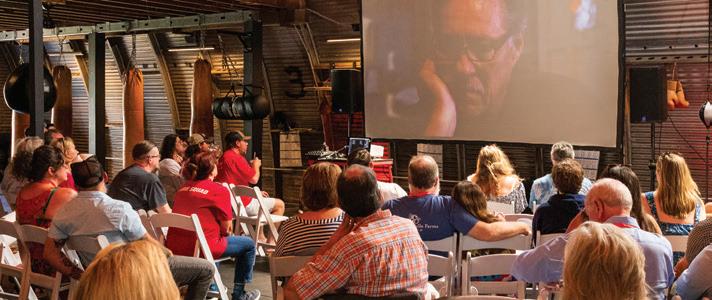



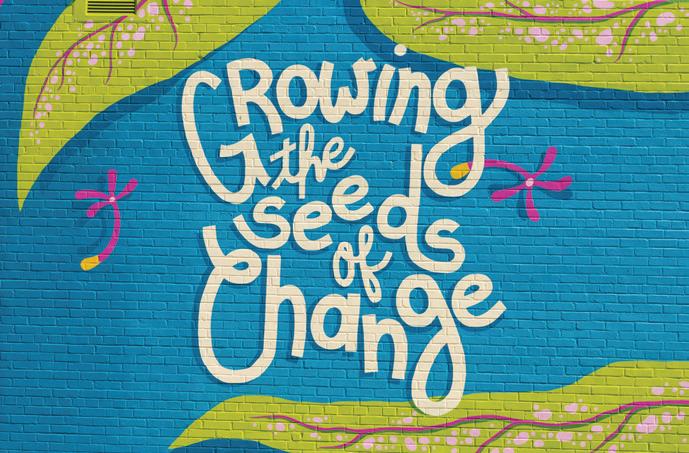




and Kevinaddressesanaudiencefollowinga documentaryshowingduringtheinauguralRedfish FilmFestinPanamaCity.
Wewa reaches that target through a process that balances creative storytelling with the companies’ business goals. Kevin develops the scripts. Courtney’s technical skills and cinematic vision combine for a powerful visual result. The final product is a documentary Kevin and his clients are proud to show.
This year, he took a leap of faith to allow other documentary filmmakers to show their work, as well, during Redfish Film Fest. And he did it in a place that he loves.
“I love the documentary form,” Kevin says. “I always have—since I was a kid. I also love downtown Panama City. I’ve always dreamed of a vibrant downtown.”
Kevin’s family moved to Panama City when he was 13 years old. He now lives with his wife and two daughters between Panama City and Wewahitchka— known locally as Wewa—to the north. Courtney lives with her family in Wewa, her hometown. While locating there and naming the company after Wewa felt right to them, Kevin’s passion for Panama City still runs strong.
He conceived the Redfish Film Fest to support the documentary film industry and his beloved downtown Panama City at the same time. The inaugural festival, held in April, brought more than 75 documentary films and filmmakers from across the country to venues throughout the city.
“I’ve been a part of the arts community in Panama City since 1988,” Kevin says, noting he has been inspired and entertained by the community’s venues, events and performances. “I’ve always gone to them and enjoyed them. This is my thing I’m giving to them. It’s a dream come true.”
The festival was, by all accounts, an enormous success. Filmmakers, audiences and local businesses were thrilled with the excitement the festival brought to Panama City. Its downtown is experiencing a bit of a renaissance and making improvements following Hurricane Michael five years ago.
“It’s an incredibly exciting time to be here,” Kevin says. “We want to show off our town now.”
The festival included five downtown film venues, plus social events at other venues. Kevin wanted attendees to fall in love with downtown as much as they fell in love with the films and the festival itself.
Kevin makes three promises to his customers. First, the client and organization will look their best. Second, the customer will be proud of the result. Third, the project will move people.
Whether the project is a Wewa Films destination marketing video, corporate recruiting video, a local artist profile or a Redfish Filmfest opening night party, Kevin ensures those promises are kept. And every project he takes on benefits from his passion for what he does.
Wewa Films’ CRAFT docuseries can be found on the company’s website at wewafilms.com/project/craft-docuseries. The next Redfish Filmfest is April 24-27, 2025, in downtown Panama City. More information can be found at redfishfilmfest.com.
By Colette Boehm
Long before Weston Wood spoke his first word at the age of 7, he made an impression on the world around him, inspiring a supportive community for scores of autistic and developmentally challenged individuals in Northwest Florida.
It’s only fitting that Weston’s first word was mama. For years leading up to that milestone, Weston’s mother, Lindy, devoted her life to finding, expanding and improving access to services
for young people like her son. As he turned 14 in August, Weston began reaping the full benefits of a chain of events that started when he was diagnosed as severely autistic as a 16-month-old.
After moving from her West Alabama home with Weston and a newborn daughter to a metropolitan area with more treatment options for him, Lindy spent two years living apart from her husband and two older children.

“The driving force that pulled me out of our hometown was that I needed to find the best therapies for Weston, and I was 100% committed,” says Lindy, a psychiatric nurse practitioner. “I didn’t want to look back and say I didn’t do X, Y or Z.”
While he made progress, she realized there was no fix.
“It took that long for us to really let it sink in that this is a lifelong disability and that this was a marathon,” she says.
Lindy realized that, even in areas where there are supportive services, autistic individuals face a service cliff after high school that threatens to rob them of their potential and their quality of life, and she knew more needed to be done. She believed it was up to her to do it.
I just had to trust that this is what I was supposed to be doing.
— Lindy Wood, owner of Westonwood Ranch
“I believe that this truly was a mission that God put on my heart,” Lindy recalls. “The pathway to make it happen wasn’t my pathway. I just had to trust that this is what I was supposed to be doing.”
That mission led the Wood family to Freeport, Florida, to what is now the 10-acre home of Westonwood Ranch. The goal of the nonprofit organization, which opened its doors six years ago, is to offer young individuals with autism opportunities to learn self-reliance, life skills and employable skills in a nurturing environment.
“We opened in August of 2018 with four very special individuals, and we’ve grown to over 50 full-time participants with an additional 40 clients in our after-school adaptive riding program and our summer programs,” Lindy explains. Ranch staff members meet with participant families to map out


each individual’s ideals, goals and what they want for their lives. The goal is to expose these young people to multiple avenues they haven’t had the opportunity to experience elsewhere.
“We’re trying to find that one little thing—that spark that makes them light up,” Lindy says. “And then we’re channeling that into something productive, into a skill that can conceivably carry them throughout their lives.”
Entry-level programs are focused on general life skills needed to live more independently, like preparing meals safely, using technology, exploring art and working out in a gym—all aimed at promoting a healthy lifestyle and life skills.
Next, the ranch helps open doors to those who otherwise might be chronically unemployed. These opportunities come through two enterprises developing life skills and experience. Brew Chews is an entrepreneurial endeavor, based at the ranch, that manufactures dog treats. Through a partnership with Freeport’s Odd Pelican Brewery, the ranch uses spent grains to create the treats. Other local businesses partner to use or resell them. The
second operation is an aquaponic greenhouse where tilapia are raised to provide fertilizer and nutrients used to grow butter lettuce. Several area restaurant partners buy the lettuce.
Ranch participants can choose from a list of jobs in these enterprises that interest them, including baking, growing, harvesting, packaging, marketing, office skills, deliveries and more. These training opportunities help participants learn marketable skills and move into full employment, either by continuing to work at Westonwood or elsewhere. Lindy believes it also provides them with a sense of purpose and a way to contribute.
In addition to its full-time offerings, the ranch offers a therapeutic riding program to participants at least 4 years old and summer programs for even more students.
The next goal for Westonwood Ranch is to add a residential community on the property that could provide housing for up to 36 people and offer varying levels of support. Lindy notes a lack of affordable housing in the area.
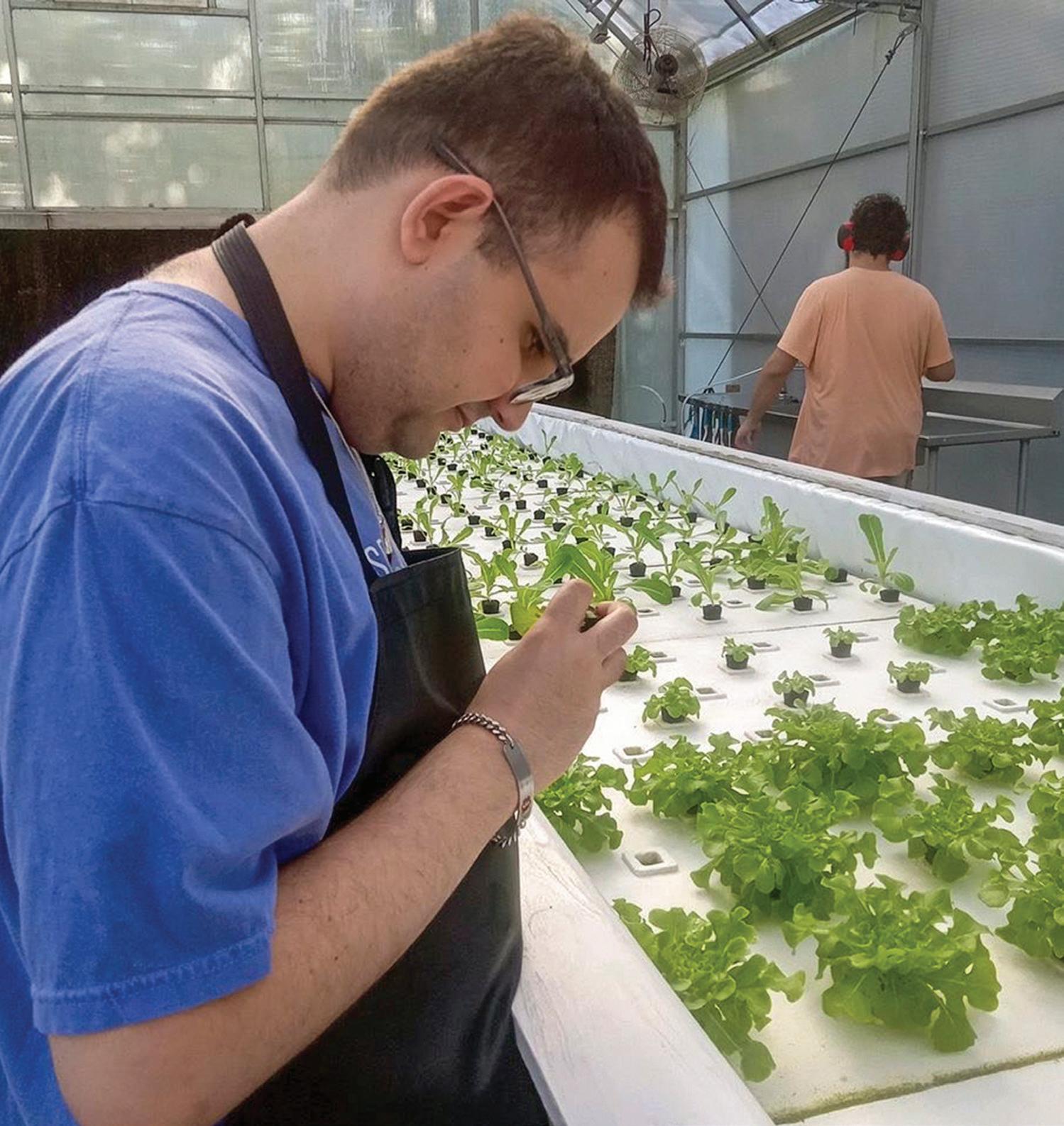
“If you have a disability and need some kind of special accommodations, your options are really narrowed. Again, we’re just trying to fill a void or a gap because most of our participants are living with aging parents,” she says, pointing out that alternative arrangements will be needed as those parents’ health declines.
Now, as a parent of a full-time Westonwood enrollee, how does Lindy view the journey she and her family have taken to this point?
“I never, ever would have imagined that this is what I would be doing at this point in my life. Not in a million years. But I see it differently now. I’m not the same person I was before I had Weston, and he’s changed my life lens and the way I see people and see experiences. And I cherish things that I ignored before.
“I’m not going to sugarcoat it,” she adds. “There are hard days. But despite how difficult it is, there are some beautiful things that come out of it that I would not have ever known or experienced without him.”
We’re trying to find that one little thing—that spark that makes them light up.
—




Recipes by Gertrude Treadaway
BY KATIE WILCOX

Mexican Street Corn Chowder
4 tablespoons butter
1½ cups finely chopped yellow onion
½ cup seeded, stemmed and finely chopped poblano pepper
4 cloves garlic, minced
1 tablespoon chili powder, plus more for garnish
1 teaspoon dried Mexican oregano
4 cups chicken stock
3 medium Yukon gold potatoes, peeled and cut into ½-inch pieces
24 ounces frozen corn
1 cup heavy cream
2 teaspoons sugar
½ cup crumbled cotija cheese, plus more for garnish
1/4 cup minced cilantro, plus more for garnish
1 tablespoon lime juice
Kosher salt and pepper, to taste
½ cup Mexican crema or sour cream, for garnish
Lime wedges, for serving
Sliced jalapenos, for serving
Melt the butter in a large pot over medium-high heat. Add the onion and poblano, and season with a pinch of salt and pepper. Cook, stirring occasionally, until the onion softens, about 7 to 8 minutes. Add the garlic, chili powder and oregano. Saute for about 1 minute, until fragrant. Add the chicken stock and potatoes. Bring to a boil, then lower the heat to maintain a simmer. Cook, stirring occasionally, until the potatoes are tender, about 15 minutes. Stir in the corn, cream and sugar. Cook for 5 minutes, until warmed through.

Transfer 11/2 cups of the soup to a blender, and puree until smooth. Stir the pureed soup back into the pot of remaining soup. Add cotija cheese, cilantro and lime juice. Season with salt and pepper.
Garnish with additional cilantro, cotija, chili powder and crema. Serve with lime wedges and jalapenos.

1 pound shrimp, deveined and tails removed
2 teaspoons Cajun seasoning
Salt and freshly ground black pepper, to taste
6 slices bacon, chopped
1 tablespoon butter
1 medium onion, chopped
2 tablespoons all-purpose flour
2 cloves garlic, minced
1 pound yellow potatoes, chopped
4 cups low-sodium chicken broth
3 thyme sprigs
2 sliced green onions, plus more for garnish
3 cups sweet corn
3/4 cup heavy cream
½ teaspoon paprika
Season shrimp with Cajun seasoning, salt and pepper. In a large pot over medium heat, cook bacon until crispy, about 6 minutes. Place bacon pieces on a paper towel–lined plate. Add shrimp to bacon fat. Cook until pink, about 2 minutes per side. Transfer shrimp to plate with bacon. Drain bacon fat. Melt butter in the pot, scraping up any browned bits with a wooden spoon. Add onion. Cook until soft, about 5 minutes. Stir in flour and garlic, and cook 30 seconds more. Add potatoes, broth, thyme and green onions. Bring to a boil. Reduce heat. Cover, and simmer until potatoes are tender, about 10 minutes. Stir in corn and cream. Simmer for 5 minutes. Turn off heat. Stir in shrimp. Season with salt, pepper and paprika. Garnish each serving with bacon and green onions.
Clam Chowder
4 slices bacon, for garnish
1 large onion, chopped
1 celery rib, chopped
2 cloves garlic, minced
1/4 teaspoon dried thyme
3 small potatoes, peeled and cubed
1 cup water
8 ounces clam juice
1 tablespoon chicken base
2 cups half-and-half, divided 1/3 cup all-purpose flour
3 6½-ounce cans chopped clams, undrained
Salt and freshly ground black pepper, to taste Oyster crackers, for serving
In a Dutch oven or large pot over medium heat, add bacon and cook until crisp, about 5 minutes. Remove bacon from pot. Drain on paper towels. Crumble bacon, then set aside. Add onion and celery to the bacon fat. Cook until softened, about 5 minutes. Stir in garlic and thyme until fragrant, about 30 seconds.
Stir in potatoes, water, clam juice and chicken base. Bring to a boil. Reduce heat, and simmer uncovered until potatoes are tender, about 15 to 20 minutes.
In a small bowl, whisk together 1 cup half-and-half and flour until smooth. Gradually stir into soup. Return to a simmer. Cook until thickened, about 1 to 2 minutes. Season to taste with salt and pepper.
Add clams and their juice and remaining cup of halfand-half. Stir until heated through, about 1 minute. Garnish each serving with bacon and oyster crackers.
2 large carrots, chopped
1 large onion, chopped
4 potatoes, chopped
32 ounces corn, drained
32 ounces creamed corn
4 cups chicken broth
1 pound bacon, cooked and crumbled
½ teaspoon thyme
1 teaspoon dried parsley
½ teaspoon garlic powder
Salt and pepper, to taste
12 ounces evaporated milk
2 tablespoons cornstarch
3 tablespoons butter
Place everything except the evaporated milk, cornstarch and butter into the slow cooker. Add just enough chicken stock to cover the ingredients. Cook on high for 5 hours or low for 7 to 8 hours until vegetables are softened.
Combine cornstarch and evaporated milk. With the butter, stir into slow cooker 30 minutes before serving. Adjust seasoning with salt and pepper, to taste.
5½ tablespoons butter, divided 11/3 cups chopped carrots
2 stalks celery, chopped
1 small yellow onion, chopped
2 cloves garlic, minced
3 cups low-sodium chicken broth
3½ cups peeled and cubed russet potatoes, cut ½inch to 3/4-inch thick
1/4 teaspoon dried thyme
3 cups chopped broccoli florets
Salt and freshly ground black pepper, to taste
6 tablespoons all-purpose flour
3 cups milk
½ cup heavy cream
2 cups shredded sharp cheddar cheese
In a large pot over medium heat, melt 11/2 tablespoons of butter. Add carrots, celery and onion. Saute for 3 to 4 minutes. Add garlic, and saute 30 seconds longer.
Stir in chicken broth, potatoes and thyme. Season with salt and pepper. Bring to a boil over medium-high heat, then reduce heat to medium. Cover, and cook for 15 minutes. Stir in broccoli. Cook 5 minutes longer or until vegetables are tender.
Meanwhile, melt remaining 4 tablespoons of butter in a medium saucepan over medium heat. Stir in flour and cook, whisking constantly, for 1 minute. While whisking vigorously, slowly pour in milk. Whisk well until no lumps remain.
Cook, stirring constantly, until mixture begins to thicken. Stir in heavy cream. Remove from heat. Add tender vegetables to the milk mixture, and stir. Remove from heat. Stir in cheddar cheese until melted. Serve warm.

Today’s word is “comfort.” Show me in a photograph what comfort looks and feels like. Think about what the word means to you, and then challenge yourself to make a photograph that communicates how you see or feel. Just as many find doing word puzzles stretches the mind and keeps the brain awake, you may discover that choosing a word to photograph might be an equally valuable exercise.
Email your best image (just one, please) with caption information, including an explanation of how it affects you, to GPH@pur.coop. We may share submissions on our website and social media channels.
By Dave LaBelle
Decades ago, magazines like Popular Photography offered monthly photo challenges. Often, abstract word prompts such as “red,” “love” or “happiness” were given. I never took the challenge, but now I wish I had.
As a teacher and photography director, I learned not all students or staff shared the same ability to give shape to abstract ideas or concepts. While most were proficient when asked to photograph an event, a person or an object,
many were unable to grasp nonlinear assignments requiring interpretation. One student even angrily confessed he had to seek mental help because I had asked the class to make two interpretive photographs: one of how they saw themselves and the other of how they felt others saw them. He said he didn’t know what he felt about himself, and it stressed him so severely he sought counseling.
Years ago, in Pittsburgh, Pennsylvania, I taught a multiweek photo class for inner-city youth. In one assignment, I asked the young students to
photograph something they loved or thought was beautiful and, in contrast, something they didn’t like or would like to change.
The dozen or so students came back with pictures of pets, family members, friends, parks and trees by the water. But they also shared photos of broken windows, graffiti on walls and trashy front yards. I was so impressed with their willingness to put in pictures what they felt was ugly and distasteful.
Interpretive photography— trying to illustrate an abstract concept or a word—requires
some introspection and a desire to share how you see and feel. Sometimes, it is a matter of setting aside your literal, documentary eyes and awakening your artistic, imaginative vision. Hopefully, those who view our photographs can see what we see and feel what we feel. n

Renowned author, photographer and lecturer Dave LaBelle has captured special moments for more than half a century. For more of his writings, visit davidlabelle.com and bridgesandangels.wordpress.com.

Over ten thousand Americans have discovered this life-changing, portable, folding battery-powered chair that offers easy one-hand operation. Isn’t it your turn?
When we first introduced the Zoomer to the public, we thought people would enjoy the handy features and benefits of this unique mobility device. We had no idea the extent to which this innovative way of solving an age-old problem would inspire people to take back their freedom and independence. We’ve received hundreds of positive reviews from people whose lives had been diminished by mobility issues. Now they are getting back in the game, enjoying the things they used to love doing:
-Shopping, visiting friends, going to church and taking leisurely strolls with loved ones.
But that’s only the beginning! Now their Zoomer enables them to navigate many situations more easily… crowded malls, uneven terrain or longer distances. It reduces their reliance on others, giving them back self-reliance and control over where they go and what they do. Studies* have shown that increased social engagement and participation in activities helps combat isolation and promotes overall well-being.
Why wait another minute watching others participate in life while you are stuck on the sidelines? Call now, and let us tell you how you can get a Zoomer of your very own.


My ability to walk long distances has been a problem. Currently with the Zoomer I no longer have to sit on a bench and wait on others. I would have to miss out on shopping or experiencing different things with my family. This chair is freedom to join in and continue enjoying life’s adventures. Best decision ever!











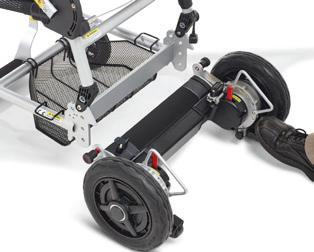







Florida offers outstanding crappie fishing everywhere
Florida offers some of the best crappie fishing in the nation, with two species found in the state.
Black crappie thrive in most waters north of the Keys. Although not native to Florida, white crappie occasionally appear in a few Panhandle streams.
Ben Curry Sr. set the Sunshine State record in 1992 with a 3.83-pound crappie he pulled from Lake Talquin. The lake covers about 8,800 acres on the Ochlockonee River in Leon and Gadsden counties, west of Tallahassee.
Anglers can catch great numbers of crappie through various methods. Many people simply hook a live minnow under a float and drop it near a fallen tree, stump, weed bed or other cover.
That old traditional approach still works, but because crappie often prefer deeper waters offshore, many people troll for them. Slow trolling, also called tight lining or spider rigging, involves hanging several long rods in holders off the boat bow. The rods make a fan-shaped pattern that somewhat resembles a huge spider web.
With multiple baits on several lines, anglers can fish numerous temptations at different depths simultaneously. Ease the boat forward with an electric motor to keep the lines as vertical as possible.
Another form of trolling, long-lining involves pulling several baits 10 to 40 yards behind the boat. Put the rods in holders on the stern of the boat. Many anglers troll tube jigs or spinner jigs, sometimes sweetened with live minnows.
In the fall, crappie feed heavily on shad. Shad hatched in the spring reach larger sizes by the fall, so many anglers looking for bigger crappie pull large crankbaits that resemble shad.
“Really large crappie hit large baits, just like bass,” says Jimmy Houston, a professional angler and television show host. “As a crappie gets larger, it eats bigger and bigger things. Big crappie hit spinnerbaits, crankbaits or even large plastic worms. With a bigger bait, anglers might not get as many bites, but they’ll usually catch bigger fish.”
Tasty, widespread and highly prolific, crappie exist throughout Florida. They populate just about every freshwater system.
Besides Lake Talquin, the entire St. Johns River system and associated lakes offer excellent fishing for large crappie and good
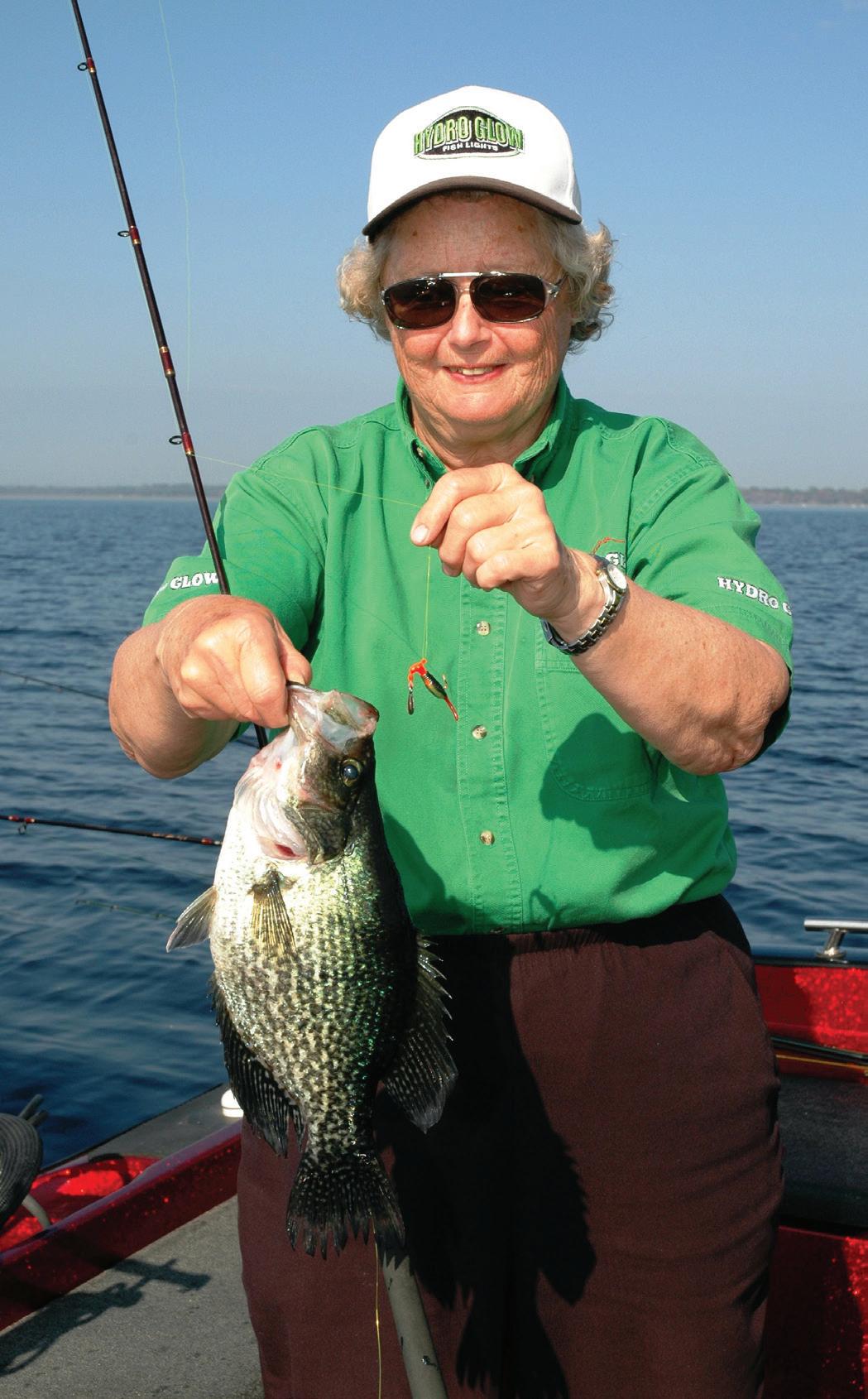
numbers. Some better crappie lakes along the river include lakes George, Woodruff, Monroe and Harney.
The largest lake in Florida, Lake Okeechobee also holds some of the biggest crappie north of the Everglades. West of Orlando, the Harris Chain produces excellent catches. Anchored by the 15,500-acre Lake Harris, the nine lakes span about 76,000 acres.
Another large chain, the Kissimmee Chain sprawls across 100,000 acres south of Orlando. Other Florida crappie waters include Lake Marion, east of Haines City; Lake Istokpoga, near Sebring; and Lake Seminole, straddling the Georgia-Florida line near Chattahoochee.
This list barely scratches the surface of great crappie waters in the Sunshine State. Chances are, unless you live in the Florida Keys, you can probably find good crappie fishing just a short distance away from home.

John N. Felsher is a freelance writer, broadcaster, photographer and editor. An avid sportsman, he’s written more than 3,500 articles for more than 170 different magazines on a wide variety of outdoor topics. He also hosts an outdoor tips show for WAVH-FM Talk 106.5 in Mobile, Alabama. Contact him at j.felsher@hotmail.com or through Facebook.


SHE FOUGHT FOR HER COUNTRY. IT’S OUR DUTY TO FIGHT FOR HER.










Wounded Warrior Project ® long-term support programs provide these brave men and women whatever they need to continue their fight for independence. At no cost. For life. Help us help more of these warriors in their new life-long battle. Find out what you can do at fi ndWWP.org.
















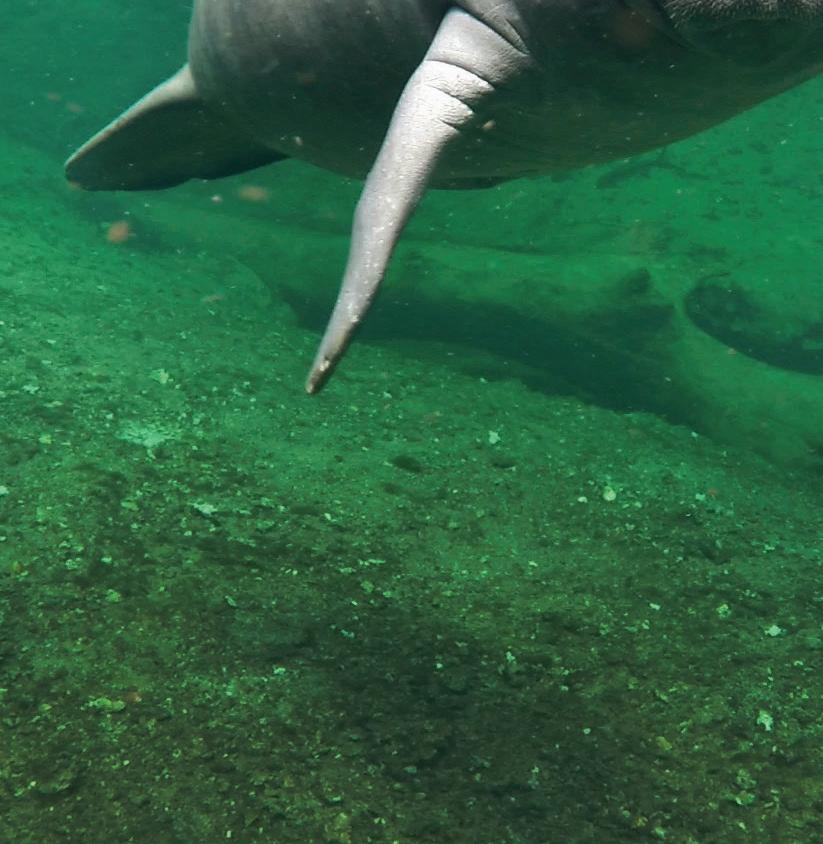



All ages can find something new and exciting around every corner of the state. Filled with rich history, abundant natural beauty and diverse events all year, Florida has something fun for everyone.
Oct. 2
Tastes of Highlands
Join the Lake Placid Farmers Market for Tastes of Highlands, where you can enjoy the incredible flavors the area has to offer. There are plenty of food and drink options, demonstration booths and food competitions. Each week offers a new food adventure starting Oct. 2 and continuing Wednesdays through the end of March. www.lakeplacidfarmersmarket.net; 863-440-7657
Oct. 3-31
40 Years of Sunsets


40 Years of Sunsets commemorates the 40th anniversary of the iconic Sunset Celebration from 6-8 p.m. at Mallory Square, a cornerstone of Key West culture. This exhibition honors the tradition of celebrating the setting sun—a practice dating back to the 1830s—which has evolved into a nightly festivity uniting people from all walks of life. The event has long supported local artists, providing a platform for them to thrive and share their talents. Half of the proceeds from the show support the Key West Cultural Preservation Society, helping alleviate the challenges posed by rising living costs and the lingering effects of the pandemic. Join us in celebrating this beloved tradition and ensuring its continuity for future generations. https://tskw.org/40-years-of-sunsets; 305-296-0458

Oct. 10
UF/IFAS Range Cattle Research and Education Center Field Day
Join us from 8 a.m. to 3 p.m. for a field day to learn about our faculty and student research, mingle with our sponsors, visit pasture experimental sites and enjoy a steak lunch. Morning presentations include “Cattle Market Outlook,” “Artificial Intelligence in Agriculture and Water Management,” “Coyote Ecology in Florida’s Rangelands” and “Benefits of Probiotic Supplementation in CowCalf Herds.” Afternoon pasture site presentations include “Feed Value of Fall Fertilized Forage,” “Smutgrass Management Techniques: Broadcast and Spot-Treatment Applications” and “Pasture Management Strategies to Increase Soil Carbon Sequestration and Greenhouse Gas Mitigation.”
https://rcrec-2024-fd.eventbrite.com; 863-735-1314
Oct. 5
Catch the Spirit Arts and Crafts Festival
The Christ Episcopal Church kitchen provides lunch while its ladies group provides drinks and lots of home baked goods made with loving care by church members. Vendors have handmade items—from wreaths to toys to smell-good stuff—on display. 850-477-8596

Oct. 5
The ReMARCable Tour de Keys
This 50- or 100-mile bicycle ride is a fundraiser for the Monroe Association for ReMARCable Citizens (MARC) and AH Monroe. MARC provides wraparound life services for developmentally and intellectually disabled adults in Monroe County. AH Monroe provides health and housing services to underserved communities in Monroe County. This is a signature fundraiser for the agencies. Each participating rider is asked to raise $100 for missions in addition to their registration fee.
https://bit.ly/4dNE9FD; 614-264-2190





Oct. 5
Barktoberfest Pet Adoption Event
Pawsitive Effects invites you to Highlands County’s largest pet adoption event from 10 a.m. to 3 p.m. in Stuart Park. Dogs and cats from nonprofit rescue organizations will be available for adoption, and vendors offer goods and services for pets and their owners. There are photos, a costume contest, pet blessings, nail trims, microchipping, memorial dedications, raffle baskets, music, food trucks, demonstrations and giveaways. Donations help support local participating rescues. For more information, visit the Pawsitive Effects Facebook page or website. www.PawsitiveEffects.org; 863-441-0351
Oct. 17
Morada Way Art Walk


Keys-inspired fine artists, vendors, residents and visitors congregate on Morada Way to celebrate the arts and culture in the Florida Keys. Enjoy perusing art from 6-9 p.m. the third Thursday of each month. www.moradaway.org; 305-664-2471
Oct. 17-27
Pensacola Interstate Fair
This fair is the largest event on the Gulf Coast. With more than 60 rides, top-name entertainers, educational exhibits and food galore, there is always something new to see. There are facilities for the agricultural, educational, scientific, livestock, cultural, commercial, and industrial resources of surrounding counties and states. The Pensacola Interstate Fair is a star-spangled parade of exhibits that attracts participants from all over the country. https://pensacolafair.com; 850-944-4500
Oct. 18
Beach-O-Ween
Get ready for a spooky good time at the sixth annual Beach-O-Ween from 4-8 p.m. at Pensacola Beach Boardwalk. There are fun activities for children of all ages, including a Halloween bounce house, costume contest, games, face painting and hot dogs. Best of all, all games and activities are free, and there is plenty of candy to go around. Grab your costumes and head to the boardwalk for a night of frightfully good fun you won’t want to miss. www.visitpensacola.com/beach-o-ween; 850-530-3349
Oct. 18-20
Ladies, Let’s Go Fishing

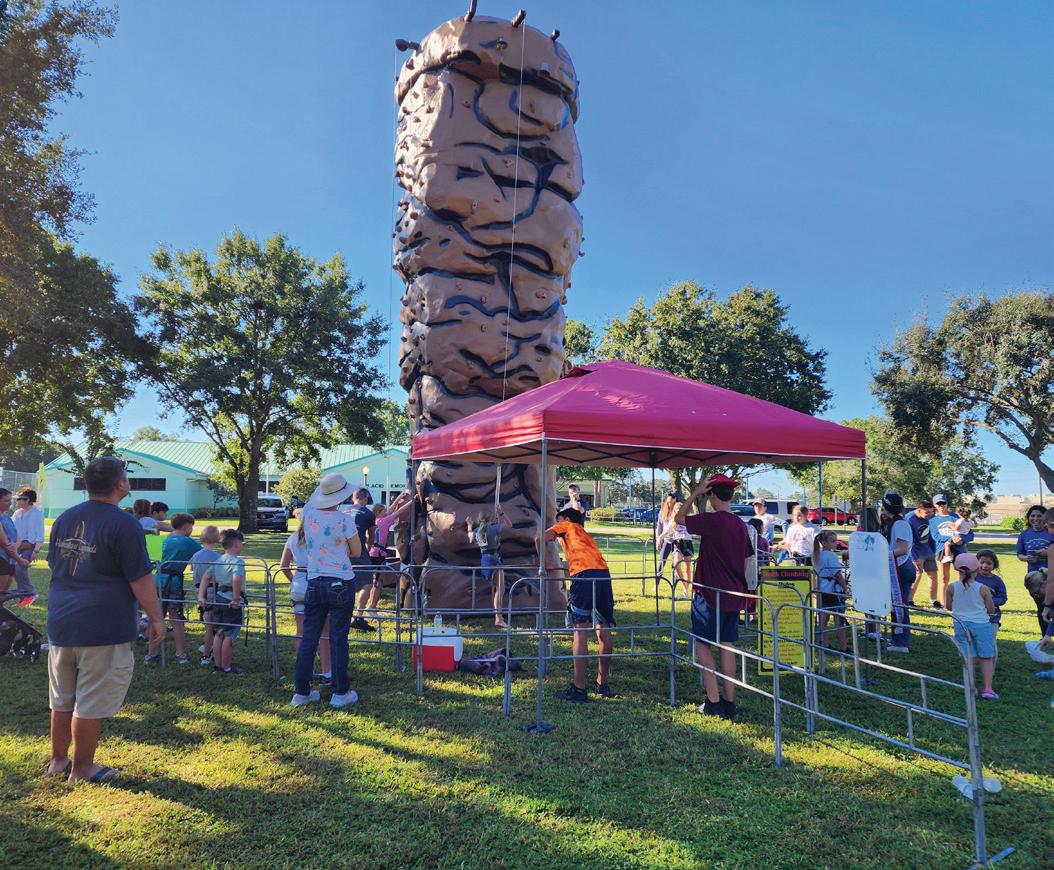
Oct. 26
16th Annual Mason G. Smoak Foundation 5K and Family Fun Day
Join us at 8 a.m. in Devane Park to walk or run a 5K through beautiful downtown Lake Placid. Stay to enjoy a family-friendly festival with free games and activities for children of all ages. Additional activities include a rock-climbing wall, bounce houses and cornhole. Barbecue dinners and lots of yummy snacks are available throughout the event.
https://www.masongsmoakfoundation.org; 863-417-5414
Oct. 20

Pumpkin Patch Street Festival and Children’s Business Fair
Enjoy free activities, children’s concerts and games for all ages beginning at noon on North Ridgewood Drive. At the pumpkin patch, find pumpkins for sale with fall backdrops available for photos. The children’s museum is also open for play with half-price admission—$4 per person. Explore the Children’s Business Fair celebrating and providing a platform for young minds’ big ideas. Children develop an idea or brand, create a product or service, build a marketing strategy and open for customers at this one-day marketplace. An awards ceremony takes place at 3 p.m. www.childrensmuseumhighlands.com; 863-451-5385

Aspiring anglers can learn, practice, go fishing and win prizes at this award-winning tournament. Hosted by the nonprofit Ladies, Let’s Go Fishing Foundation, the No-Yelling School of Fishing offers classroom presentations, two networking events, hands-on skills practice, optional charter boat fishing and the Fishing Fever Tournament. Classes are at the waterfront Elks Lodge in Tavernier. No equipment or experience is necessary. Optional offshore or inshore charter fishing out of Islamorada is offered on Friday and Sunday, with prizes awarded for the tournament. Participants can also fish from their own boats. www.ladiesletsgofishing.com; 954-475-9068

Oct. 25
Fall-O-Ween on the Circle
Greater Sebring Chamber of Commerce hosts this free event. Activities include trunk or treat, face painting, games, music, a monster mash, and Lil Pumpkin Princess and Pumpkin Princess pageants. This is the second year the haunted maze is inside Circle Theatre. The haunted maze is a ticketed activity from 5-10 p.m. Tickets are on sale now. www.sebring.org; 863-385-8448



Want to share a family-friendly event with the readers of Florida Currents? Head online and enter the details at tinyurl.com/FloridaCurrents. Make sure to submit the item at least 60 days before the event (due to press deadline). If you own rights to a print-quality photo promoting your event, include it with photo credit information.


For many gardeners, their yard is their sanctuary. It’s a place of peace and quiet in a busy world.
Unfortunately, there may be trouble in paradise. Invasive plants are more than a threat to our ecosystem and economy; they’re a threat to the tranquility of our landscapes.
In the world of horticulture, many invasive species begin as landscape favorites. That fabulous filler shrub may fill your garden inch by inch and then row by row. Suddenly it’s in your neighbor’s yard, too. Worse still, over time it crowds out native species. This deprives native wildlife—such as birds, bees and butterflies—of food and shelter.
In the past century, more than 50,000 plant and animal species have been brought to and established in the United States. About one in seven becomes invasive.
Countless ornamentals listed as invasive are still in production, found wherever garden supplies are sold. They’re attractive, and they don’t come with warning labels or caution signs.
So, what’s a gardener to do?
Take these three steps to remove problem species and restore tranquility to your garden: research, remove and replace.
Before you pull out, share or buy a plant, do your research. Check with the University of Florida IFAS Assessment of Non-Native Plants in Florida’s Natural Areas for a plant’s invasive status. The assessment includes pictures to help identify the plant in question. The information is specific to North, Central and South Florida. What about the anonymous plants in your garden? Sometimes even plant ID experts have trouble identifying a species. Other times, it’s been there so long you’ve forgotten a plant’s name.
In these cases, your best option is to contact your county extension office for help identifying the plant.
Once you’ve identified a problem species, it’s time to remove it. With invasive species, this is often a challenge. They are, by nature, hard to remove.
Generally, mechanical control methods—such as pulling out the plant—should be tried before chemical control is attempted. Be sure to bag all plant debris and dispose of it in the regular, landfill trash. This keeps cuttings and seeds from being established elsewhere. Many tough groundcover species can be difficult to remove by hand. In these cases, save your strength and let the sun kill them instead.
In the hotter months of the year, cover the area with clear plastic. Then, bury the edges to keep it secure and wait. This process is called soil solarization and is simple and inexpensive.
After six weeks, the plants underneath should be dead. However, Prolonged periods of cloudy weather may require extending the treatment period.
In extreme cases, a targeted application of herbicides may be

necessary. Stumps of trees, for example, should always be treated with an appropriate herbicide to prevent regrowth.
Before applying a pesticide, it’s important to educate yourself.
Irreversible damage to your landscape is possible. Some herbicides are also toxic to humans. Reading and following all label instructions is required by law.
Consult the Florida Homeowner Herbicide Guide for more information.
Once an invasive plant is removed, it’s time to fill the hole.
Gardeners can choose from native species, Florida-friendly nonnatives and sterile (non-fruiting) varieties. Many alternatives are bred at the University of Florida.
Lantana, for example, is a popular landscape plant. Unfortunately, it is also listed as invasive in North, Central and South Florida. Native replacement options include beach sunflower, pineland lantana and tropical sage.
There are also several non-native but landscape-safe substitutes: African bush daisy, blue daze, rose, and autumn or scarlet sage.
However, for gardeners reluctant to lose their lantana, there is a third option: a sterile variety.
Recently, the University of Florida released three sterile varieties of lantana: “Bloomify Red,” “Bloomify Rose” and “Luscious Royale Red Zone.” More are in production and coming soon. n

Natasha Atlas graduated from the University of Florida’s Agricultural Education and Communication Program in 2021. She loves writing about unique and new varieties of flowers and plants for the Neighborhood Gardener Newsletter and its 10,000 subscribers. When she isn’t writing, she enjoys tending her own garden on her balcony.
For Rent
Horse barn with five stalls, paddock and about 4 acres of pasture in Wewahitchka, one block from the old courthouse. Lease by the stall, with discount for multiple horses. 740-334-0341.
12 acres coastal Bermuda pasture. Irrigation available. 850-814-7015 or 850-814-6078.
For Sale
Herd dispersal: 100% ABGA registered goats—kids, does and bucks. 850-849-2426.
Miniature donkeys. Jacks and jennies; black, brown, gray and paints. All ages. $300 and up. Make great pets. Also, standard donkeys. Betty, 850-899-7424.
Old propane gas tank, without tag on valve. Would be OK to be made into a barbecue grill. $50. Also, 30 ft. aluminum dual axle boat trailer. $1,000. 850-639-3645.
Real Estate
FSBO: Two adjacent lots, about 2.5 acres on paved road, 10 miles north of Wewahitchka, 45 minutes from beaches. Border the Chipola River and Cypress Creek. Cleared and ready to build. Quiet and peaceful; no neighbors. Deeded restrictions. Underground utilities, deep well, many fruit trees. $69,900. 850-648-4214.
Three-bedroom, two-bath home on 1-acre lot on the Choctawhatchee River at Cedar Log Boat Ramp, 80 Old Creek Road, Ponce de Leon, FL 32455. Wayne, 850-373-7944; or Jason, 850-258-1085.
2.5 acres lakefront on Deerpoint Lake, 30 to 45 minutes from Panama City. Paved road, electricity, septic, close to schools, quiet and peaceful. Can be divided. 850-265-5554.
Half-acre corner lot. 850-639-2220.
Miscellaneous
Kapua Kleans for your final interior cleanup, deep clean, residences, condos, rental properties. Steph, 850-704-2412.
SLR Farm & Landscaping. Lawn care, grass cutting, bush hogging, backhoe work. 706-575-4570 or 850-703-5321.
Hamco Business Solutions is conveniently located in downtown Panama City with its warehouse in Lynn Haven. Hundreds of products at discounted prices, including receipt paper, ink cartridges, deli paper, kitchen paper and copy paper. Free, same-day delivery on most products. Shop local and save. Call for a free quote, 850-942-5600.
Merchant Management Group is a local payments technology company based in Panama City, working with quickservice restaurants, full-service restaurants and retail shops and specializing in the latest point-of-sale systems, including Tabit, OrderCounter and Clover. Have worked with hundreds of Gulf Coast businesses since 2004 and have an A+ rating with the BBB. Schedule your demo, 850-747-0664.
Rachel’s Facials, Lashes and Brows at 2518C Highway 77 in Lynn Haven. Now offering full body waxing and esthetician services, including back facials, extractions, chemical peels, eyelash extensions, brow and lash tinting, and makeup artist services. Rachelsflb.com or call 850-896-4855.
The 850 Stump Grinder LLC. Free estimates, multistump discount, residential and commercial. Veteran-owned and -operated. 850-814-0720.
Eco-X LLC. Guided kayak/ paddleboard eco-tours on clear freshwater springs. Hike Florida trail segment #36. Private, primitive camping. Paddle, Hike, Camp. Your local guide to adventure. 850-326-9116.
WJ Land Management. Florida licensed and insured. Forestry mulching, land clearing, culverts, fencing. Fast, free and reliable estimates. William, 850-628-4714; or Tabatha, 850-628-4713.
Koastal Home Repair LLC. Fencing, decks, painting, light tractor work, repair work and maintenance. Insured. 850-227-5509.
C&2 Electrical Services LLC. Residential and commercial electrician services. 850-899-8218 or 850-899-8217.
Carter’s Land Clearing and Mulching LLC. 850-527-4715.
Custom fences built on your property. Call David for your free estimate. 850-819-9987.
Tree Be Gone. For all your tree needs, from trimming to complete removal. 850-819-9987.
Handyman services. Painting, flooring, building repair, odds and ends. Free estimates and fully insured. TJ, 207-612-8255 or 207-578-1830.

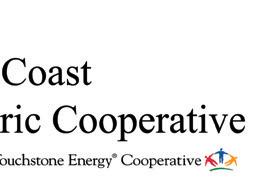
Trading Post is a FREE service to Gulf Coast Electric Cooperative members. GCEC reserves the right to edit or reject ads. PLEASE PRINT LEGIBLY OR TYPE.
Please circle the category that applies: For Rent For Sale Real Estate Free Miscellaneous Trade Wanted Items:
Name: Phone:
Address:
Mail your ad to: The Trading Post; Gulf Coast Electric Cooperative; 9434 Highway 77; Southport, FL 32409; return with your electric payment; or email ad information to tradingpost@gcec.com.
** Due to press deadlines, please expect up to 60 days from submission for your advertisement to appear.

Adhering to the Seven Cooperative Principles, Gulf Coast Electric Cooperative employees participate in training
Gulf Coast Electric Cooperative employees recently participated in a training session led by Eddie McKnight of McKnight Associates based in South Carolina.
Eddie, an electric cooperative employee for more than 40 years, retired in 2014 and now travels nationwide, sharing his knowledge with utilities to help their consumers. He developed the Member Conversations class, and this training helps member service representatives provide answers to the most-asked questions of utility customers across the nation.
The class covers branding, customer service, teamwork and member engagement. Attendees learn how to
address billing and energy-efficiency questions. Tabletop demonstrations on infiltration, insulation, lighting, lighting color, weather stripping, solar and duct sealing provide hands-on learning. Employees also learn how to better assist members interested in solar power.
“One of the Seven Cooperative Principles is Education, Training and Information,” says Kristin Douglas, GCEC vice president of marketing and communications. “Education and training for our employees helps them effectively contribute to the development of the cooperatives and helps boost cooperative understanding.” n
• INNOVATION DRIVEN BY YOU—Members help co-ops adapt and innovate to meet changing needs.
• BUILDING CONNECTIONS—When you keep it cooperative by supporting co-ops, you’re building community connections and strengthening our shared potential.
• SUPPORT COMMUNITIES—We invest in the areas we serve to help everyone succeed.
• PROMOTE GROWTH—Our members support us, and we support their communities with jobs, scholarships, sponsorships and more.
October is National Co-op Month!
Mutual aid programs are how co-ops help each other quickly respond to disasters
By Jennah Denney
Electric cooperatives employ a variety of methods to reduce the likelihood of power outages, from regular tree trimming to equipment maintenance and repairs to local grid updates. But outages occur, and when they do, co-ops are ready to respond.
Another way co-ops prepare for major outages and disasters is through mutual aid, which is a collaborative approach to emergency planning. The mutual aid model allows electric co-ops to help each other during times of need. This approach permits co-ops to “borrow” restoration workers from other co-ops, thereby increasing the workforce response to areas affected by a major outage. It’s essentially about neighbors helping neighbors, even when those neighbors are fellow co-ops thousands of miles away.
Electric co-ops operate according to seven principles. Principles six and seven, Cooperation Among Cooperatives and Concern for Community, are directly connected to the mutual aid model.
Electric co-ops were formed to provide reliable electric service to their members at the lowest reasonable cost, and mutual aid has always been a fundamental part of their DNA. The concept of mutual aid originated with rural electrification efforts in the 1930s. From the beginning, electric co-ops relied on each other to provide an essential safety net in times of crisis.
Mutual aid ultimately benefits co-ops’ consumer-members. During major outage events, co-ops can increase their workforces and respond more quickly, leading to shorter outage times for members.
Disaster response and mutual aid are managed by electric co-ops, as well as their statewide organizations. The statewide organizations help coordinate among
states, helping ensure there is adequate personnel and equipment, which are the key ingredients of the mutual aid recipe. These efforts require effective logistics management and experts who fully understand resource allocation and have the expertise to respond under pressure.
During major outages, a variety of equipment is necessary to complete repairs, including bucket trucks and other specialized vehicles, utility poles, transformers and wires. Skilled lineworkers, tree trimmers, damage assessors and other key personnel are often shared among co-ops. These experts provide critical skills and a workforce to speed up the restoration process.
Because the national network of transmission and distribution infrastructure owned by electric co-ops has been built to federal standards, line crews from any electric co-op in the United States can arrive on the scene ready to provide emergency support, secure in their knowledge of the system’s engineering.
Mutual aid embodies the spirit of cooperation and resilience that electric co-ops have fostered since their inception, even in the most challenging crises. The goal is to restore power as quickly and safely as possible after a major outage event. As co-ops continue to adapt and grow, this collaborative approach ensures communities remain connected and supported. n
TOP AND OPPOSITE PAGE: Lineworkers from Gulf Coast Electric Cooperative help restore power to members of Talquin Electric Cooperative after a severe storm. By sharing resources, co-ops can significantly enhance response capabilities.
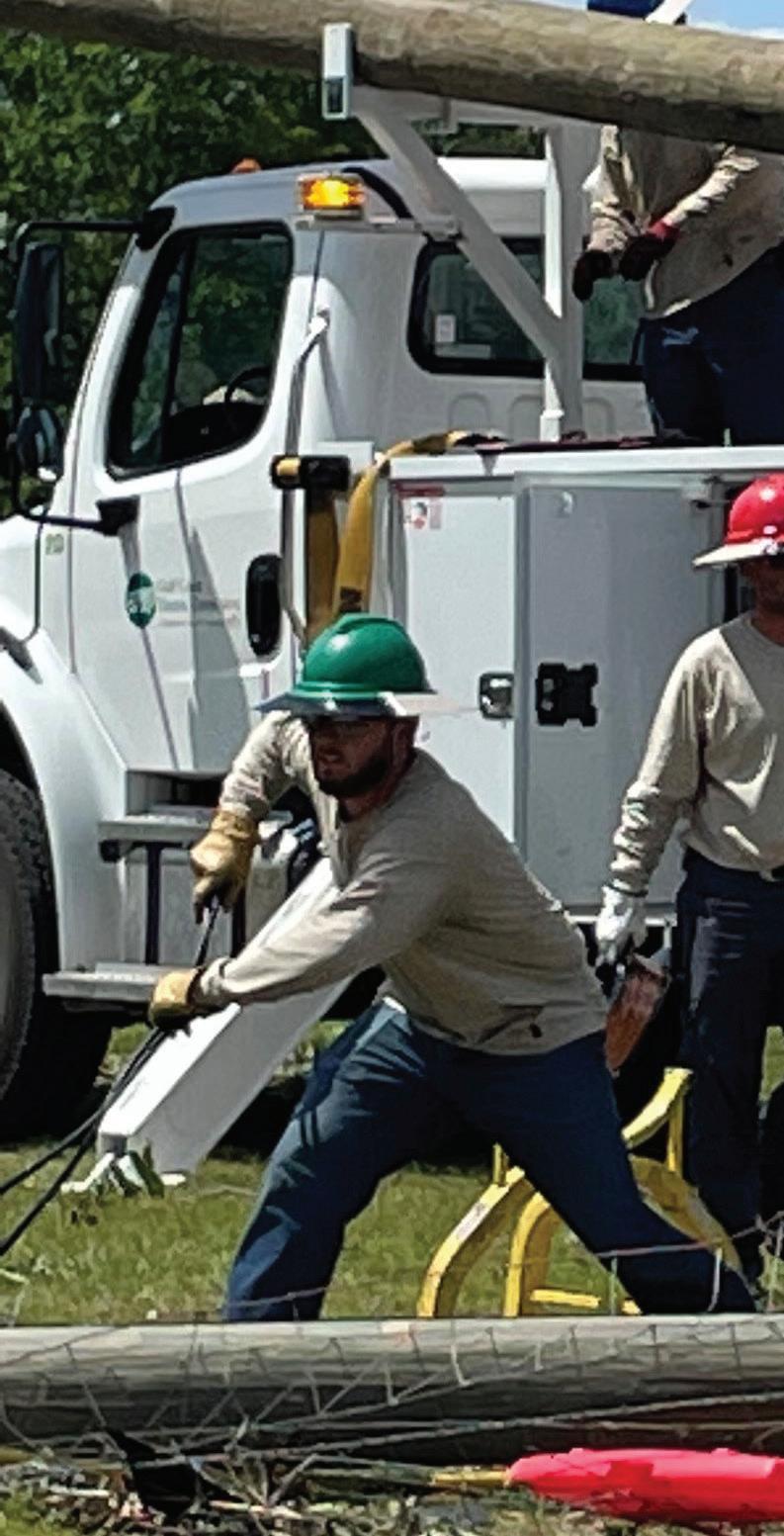
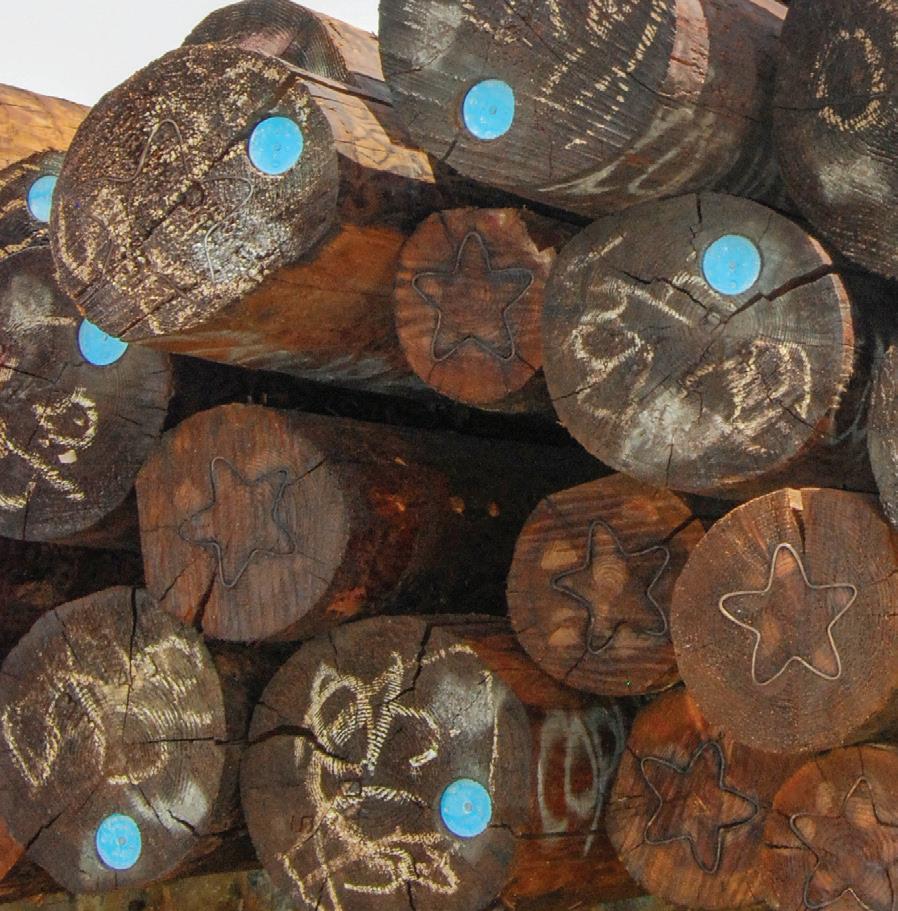


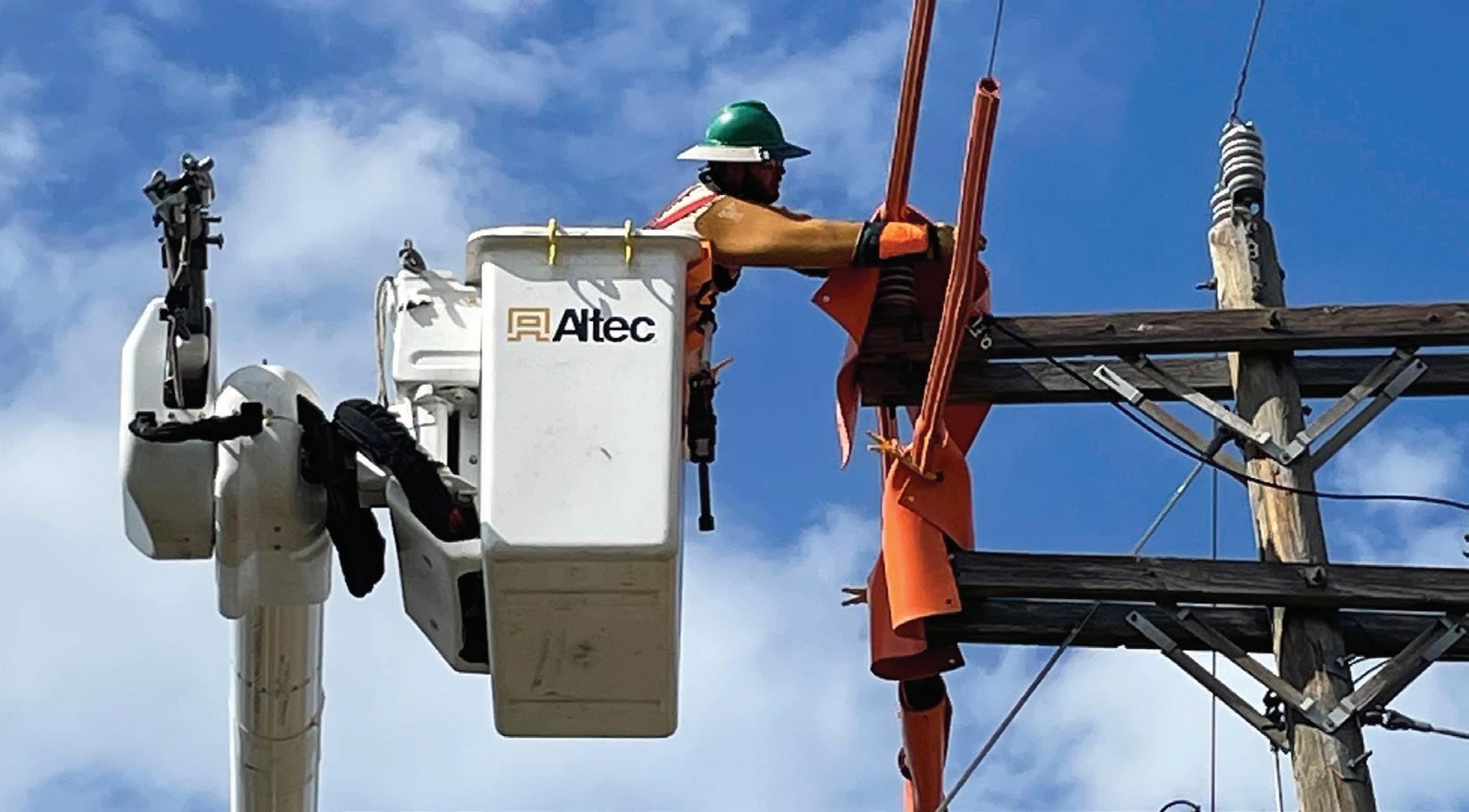
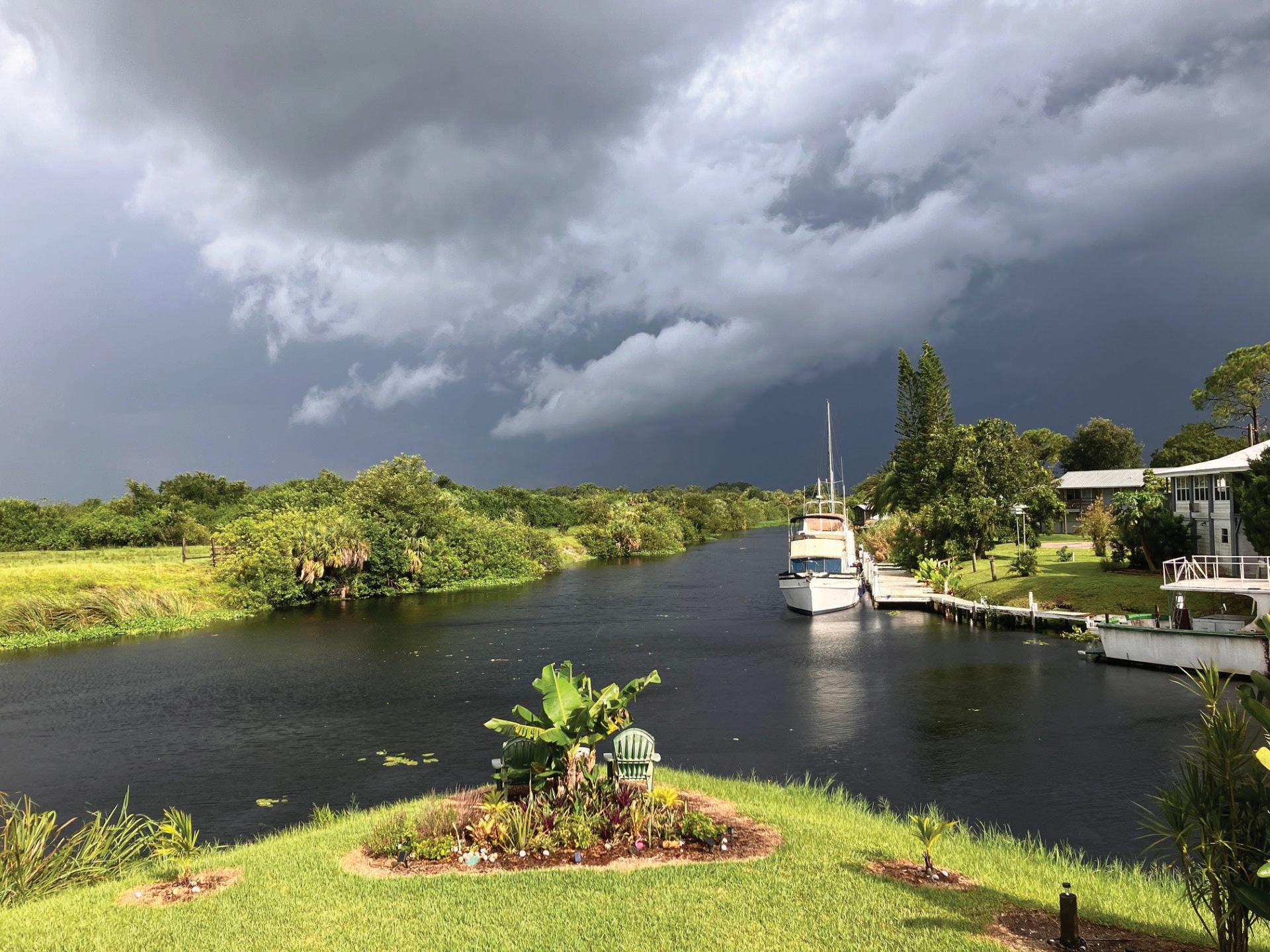
Living on a canal off the Caloosahatchee River presents interesting views, from storms to
Florida’s geography is vast and beautiful, from lakes to oceans and parks to beaches. Some of you have views from your homes that rival the views of national parks.
From time to time, we share some of readers’ photos in this space. If we use
your photo here, we will send your choice of a $25 gift card to REI or Amazon.
To submit your photo, email a JPEG file to photos@floridacurrents.com. Include “Before You Go” in the subject line. Please share a bit about what inspired you to make your photo. n
Required by 39 USC 3685
Filed with the USPS on 9-09-24
FLORIDA CURRENTS, (ISSN 23276304, USPS 8300), is published monthly at 5625 NE Elam Young Parkway, Suite 100, Hillsboro, OR 97124. Twelve issues are published annually with a subscription price of $7.52 paid by utility members in their electric bills.
The name and complete mailing address of the publisher is: Pioneer Utility Resources Inc., 5625 NE Elam Young Parkway, Suite 100, Hillsboro, OR 97124.
The name and complete mailing address of the editor is Mike Teegarden, 5625 NE Elam Young Parkway, Suite 100, Hillsboro, OR 97124. The owner is Pioneer Utility Resources Inc. (PUR). There are no known bondholders or other security holders.
PUR is a nonprofit organization mailing under DMM Section 423.12. Its purpose, function and nonprofit status for federal income tax purposes has not changed in the preceding 12 months.
No. Copies Each Issue During Preceding 12 Months
I certify the statements made by me are correct and complete. Chasity Anderson, Editor













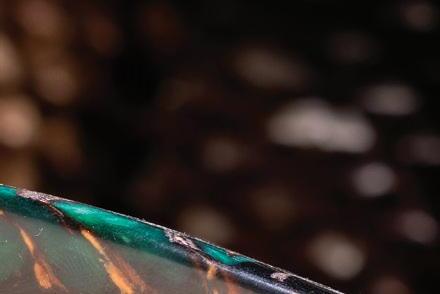

What Stauer Clients Are Saying About Our Knives

“Outstanding knife of high quality and a great price. I now have a number of your great cutlery in my growing collection!”
— Robert F., Richardson,
TX







e know you. You’re not interested in everyday, run-of-themill, common cutlery. You want something with a story, a unique feature that you can brag about. We’ve got just the thing for you. Our Mighty Conifer Knife is a unique tool with a Damascus steel blade and a handle crafted from an enhanced and stabilized natural pinecone. While our competitors are charging hundreds for similar knives, we’re offering the Mighty Conifer for JUST $99! at’s what we call our Stauer Impossible Price.



Join more than 389,000 sharp people who collect stauer knives
Each pinecone — and therefore, each knife — has its own unique characteristics. And the back of the handle features hand tooling, a further demonstration of each piece’s individual nature.
e blade is nothing to scoff at either. Constructed of Damascus steel, a modern reworking of the legendary steel forged by ancient swordsmiths, this nearly 5-inch blade features 256 layers of steel that have been folded on top of each other to increase its durability. Our competitors are charging hundreds for boring, run-of-themill knives with no features worth bragging about. We’re asking JUST $99 for a knife unlike any you’ve seen before!
With its full-tang construction and high-quality genuine leather sheath, the Mighty Conifer Knife is the perfect blade for the










person who wants to stand out. CALL NOW! If you’re one of the first 700 587 callers for this ad, we’ll throw in a pair of Stauer 8x21 Compact Binoculars — a $99 value — ABSOLUTELY FREE!

Satisfaction guaranteed or your money back!



Knife Speci cations:
• 9 ½" overall length. Full-tang construction
• Damascus steel blade and natural pinecone handle
• Genuine leather sheath
Mighty Conifer Knife
$299 $99* + S&P Save $200
*You must use Insider Offer Code: MCK213-01 to get this price.

Stauer 8x21 Compact Binoculars a $99 value with your purchase




California residents please call regarding Proposition 65 regulations before purchasing this product.
1-800-333-2045
Your Insider Offer Code: MCK213-01
Offices
722 W. Highway 22
P.O. Box 220
Wewahitchka, FL 32465
850-639-2216 or 800-333-9392
9434 Highway 77
Southport, FL 32409
850-265-3631
Outages: 800-568-3667
6243 E. Highway 98 Panama City, FL 32404
850-481-1188
www.gcec.com
ceO/General ManaGer
John Bartley
TrusTees
President Dwight Van Lierop
Vice President Betty Moore
Secretary/Treasurer Jimmy Black
Doug Birmingham
Rupert Brown
Robert Byrd
Carl Goodson
Eddie Jones
Trustees normally meet the third Tuesday each month at 12:30 p.m. CST.
The mission of GCEC: Fulfilling the changing needs of our membership and communities by providing costeffective, reliable and safe utility services through a dedicated and responsive workforce.
Communities come in all shapes and sizes. Some are based on geographical proximity, some on shared interests or hobbies, and some can be found in virtual spaces such as social media groups. Communities can bring people together and create a sense of belonging regardless of where or how they are formed.
Gulf Coast Electric Cooperative is deeply committed to our members, and we’re glad you are part of the electric cooperative community.
This October, more than 30,000 cooperatives across the United States are celebrating National Co-op Month. It’s a time to reflect on all the aspects that set apart cooperatives from other types of businesses. More importantly, it’s a time to celebrate the power of co-op membership.

Electric cooperatives are not-for-profit utilities built by the communities they serve. GCEC’s mission has always been to provide you with reliable power. We care about your quality of life, and because we are locally operated, we’re uniquely suited to meet your evolving energy needs.
Beyond the business of electricity, our employees and directors are equally invested in our local community because we live here, too. That’s why we work hard to support local economic development projects, youth programs and scholarships, charitable giving initiatives and additional programs that make our community a better place to call home.
All co-ops, including GCEC, are guided by Seven Cooperative Principles that embody the values and spirit of the cooperative movement. These principles are a framework to help all co-ops navigate challenges and opportunities while remaining true to our purpose:
1. Open and Voluntary Membership. Co-op membership is open to anyone who can use the co-op’s services.
2. Democratic Member Control. Members make decisions that shape the cooperative. Co-ops are created by the members, for the members.
3. Members’ Economic Participation. Members contribute money to the co-op to make sure it runs smoothly now and in the future. At GCEC, this happens through paying your energy bills.
4. Autonomy and Independence. Co-ops are independent and can operate on their own, which ultimately benefits members.
5. Education, Training and Information: Co-ops continuously focus on education to ensure employees have the training and information they need to make the co-op successful.
6. Cooperation Among Cooperatives. Co-ops share with and learn from other cooperatives. We help each other out in times of need because we want other co-ops to thrive.
7. Concern for Community. All cooperatives work for the greater good of the local communities they serve. Co-ops give back to their communities to help them thrive and grow.
This October, as we celebrate National Co-op Month and the power of membership, we hope you recognize the many aspects that set apart electric cooperatives. Our mission is reliable power. Our purpose is people—the local communities we’re proud to serve.